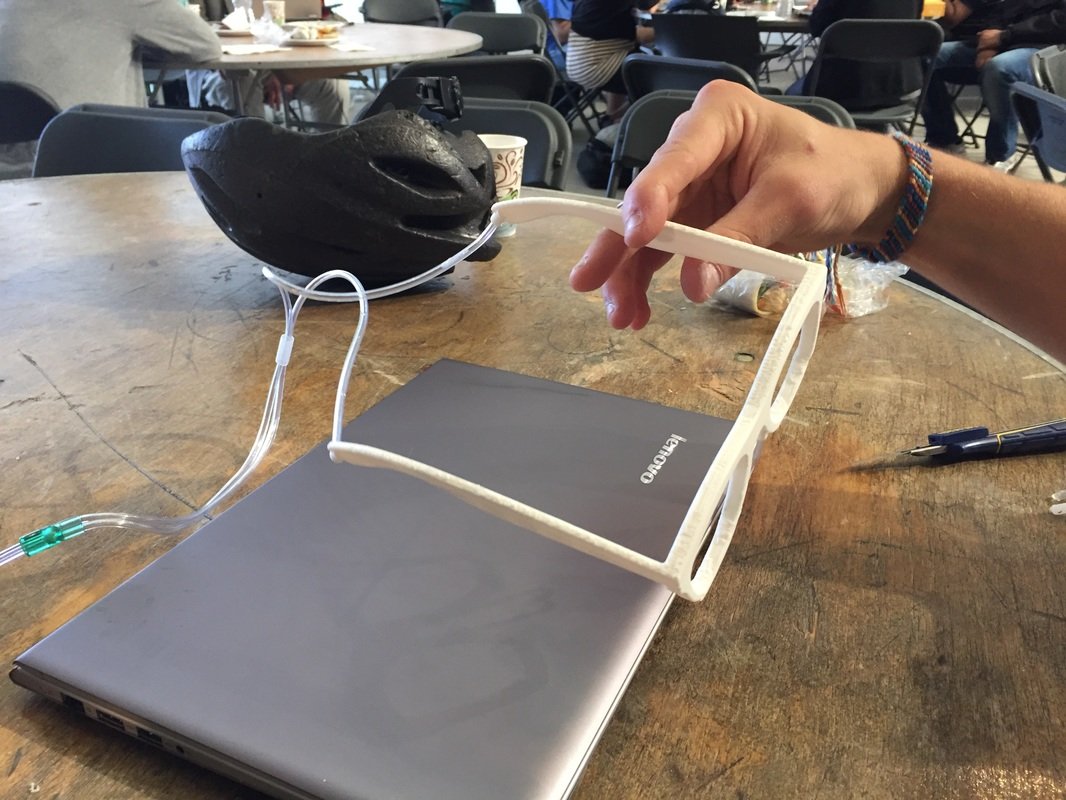Hackathons
Over the years I’ve participated in several hardware hackathons.
1st Place - Food Hackathon For Kids
Motivation and Problem:
The challenge was how to support parents and children in effortlessly establishing healthier eating, drinking, and lifestyle habits?
Solution:
Our team decided to take a toy approach and use our Seed Quilt technology (see Hamama) to create a new kind of Chia Pet. Called "The Salad Sultan" this wire frame could hold and grow Seed Quilts that kids could then harvest and eat. By participating in the activity, the kids would be more involved and willing to try the food they grew.
Food Hackathon Media
1st Place - Assistive Technology Hackathon
Motivation and Problem:
Colleen, an MIT student who uses a wheelchair, sometimes falls when getting out of her wheelchair and has difficulty getting back up. She needs to be seated in order to transfer to her walker and then back into her chair. Our team designed a system that she could move herself to that provides a lift assist to get her up high enough to stand back up with the assistance of a walker. A scale embedded into the seat of the power lift chair also provides weight information which is also difficult to obtain without a special scale meant for a wheelchair. This information is sent to an online interface for easy visualization and tracking.
Solution:
We created a relatively inexpensive frame using wood and incorporated a linear rail/actuator system to provide the lifting force. The user can control the up and down of the chair using a joystick. The prototype worked so well that we installed it in Colleen's dorm room!
Assistive Technology Hackathon Media
1st Place - Breathe Hackathon
Motivation and Problem:
One of the largest, but often ignored problems associated with COPD is individual comfort. Many with COPD have to wear a cannula which delivers pure oxygen via the individual's nose to supplement the oxygen missing from suboptimal breathing. Besides being very noticeable, the cannulas being vinyl tubing can rub and tangle around the user, especially when they are sleeping.
Our team decided that our time would be better spent designing comfort-based solutions that could be implemented immediately by the users, rather than waiting for a company to generate most of the electromechanical solutions pitched at the hackathon.
We focused on comfort during the day and during the night.
Solution:
Daytime Use: Cannulas can be very uncomfortable and draw unwanted attention to the user. To solve this problem, we created a pair of 3D printed glasses frames that had an embedded air line printed into the structure. By connecting the tubes of the cannula to the temple part of the glasses, the oxygen was routed to the nose via the frames and small tubes up into the nostrils. With different colors, styles, and using their prescription lenses, individuals can use a cannula without it being apparent.
Nighttime Use:
To provide more comfort and less likelihood of tangling while sleeping, we designed a sleep mask that routed the cannula cables up and out of the top towards the top of the head (i.e. the central axis of the person). That way there was less of a likelihood of tangling should the person roll over in their sleep. It also provided the intrinsic benefits of darkness and holding the cannula in place.
Breathe Hackathon Media
3rd Place - Make the Breast Pump Not Suck Hackathon
Motivation and Problem:
The benefits of breastmilk are abundant, the WHO recommends feeding breastmilk for the first two years of life. There are many challenges to breastfeeding, and the experience induces stress and anxiety. Studies have shown that interventions can increase breastfeeding x10 compared to controls, yet support for breastfeeding mothers remains expensive and relatively inaccessible. Electric breast pumps can help mothers avoid having to use formula, yet even though they have been around for over 30 years, they have not evolved beyond minor improvements; the experience of using a breast pump remains a frustrating one, and compliance levels still fail to rise to desirable levels.
Current state-of-the-art breast pumps remain devices which induce stress and anxiety. They are merely vacuum pumps which produce a sinusoidal-waveform vacuum with some limited control over period/amplitude. Even though there is evidence to show that different users have different optimal conditions, the pumps are developed in a one-size-fits-all model which does not learn or customize to the user, with few minor exceptions. Most pumps collect no data and provide no data. Many of the variables from a given pump (volume of milk, time of pumping, time of day etc.) are often recorded manually by the mother. The pumping experience is a stressful one in nature, and coincides with several other stress inducing life events such as labor and delivery, and early parenthood which brings with it interrupted sleep patterns and stress. Milk expression difficulties adversely affects the health of the baby and thus introduces performance anxiety and intensifies postpartum depression and postpartum anxiety for the mother. The fact that maternal stress impairs the milk ejection reflex creates a negative feedback loop.
Solution:
Intelligent pumps, improved user interaction, and easier access to better informed care all have the potential to radically improve outcomes. We proposed and prototyped a system that pairs intelligence and data collection, with an app infrastructure of assistance, advice, and support to not only improve the experience of pumping, but to also quantify issues and trends that a professional could interpret and use to provide assistance to the mother.
We equipped a Lansinoh Breast Pump with bluetooth capabilities and connected it to vacuum sensors. The sensors allowed us to see how much vacuum was being pulled by the pump, and how good of a seal was at the breast and flange. We were able to plot these values over time. Our vision is that these data would be passively collected and used to assist lactation specialists in the case that there were problems pumping.
Breast Pump Hackathon Media























